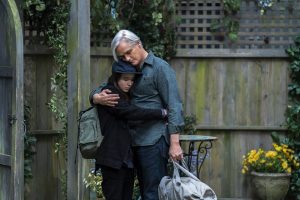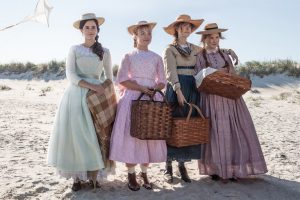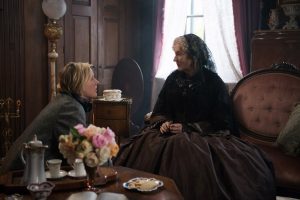I feel absurdly late to this party – the first Tales of the City series came out in 1993, and even this 2019 modernized reboot debuted weeks ago: but because it’s still Pride Month and I only just got around to watching the show, I’m going to trust my instincts, just as Anna Madrigal would say, and try to live by the “better late than never” mantra.
Obviously, SPOILERS AHEAD! If, like me, you haven’t watched Tales of the City yet (stop judging me), then beware! Back away! Avert your eyes!
And for those of you who finished the series ages ago, come on in! Let’s take a leisurely stroll up to 28 Barbary Lane and discuss what happened in a season full of twists, turns, surprises and shocking secrets. And, near the end of our little conversation here, allow me to explain why I think there should be a sequel.
Firstly, let’s talk in-depth about our main leads, specifically Shawna Hawkins (Elliot Page), Brian Hawkins (Paul Gross), Mary Ann Singleton (Laura Linney) and Michael Tolliver (Murray Bartlett). All of them had some great moments, and some genuinely cringeworthy ones, but only Brian and Mary Ann got to fill out a complete character arc, in my opinion, and that’s why they’re my favorites of the show’s leads – excluding Anna, we’ll get to her later. Brian was honestly my least-favorite after the first episode, where he proved himself to be a hypocritical and jealous lowlife who still held a grudge against his ex-wife Mary Ann, after she left San Francisco twenty years prior to start a business. I could even have understood his point of view, had he not been as aggressive as he was, and so over-zealously protective of his and Mary Ann’s daughter, Shawna. Mary Ann, on the other hand, was sympathetic but incredibly irritating; naive, exuberant, ever optimistic (even when the wheels snapped off her luggage carrier), and perpetually unable to sympathize or even understand anyone else’s opinions. The two characters have romantic tension, but their meeting leads to constant bickering and relentless melodrama – which is only exacerbated when Mary Ann discovers that Shawna doesn’t know she’s adopted. One thing leads to another, and before you know it Brian and Mary Ann are back together. That would have been lame and annoying had not the writers and actors done such a good job of portraying the changes in their characters: somehow, by the last few episodes, I found myself waiting for Brian to make jokes rather than start fights (and make jokes he did, providing some of the best comic relief).
Michael Tolliver, the more-than-slightly stereotypical “gay best friend”, takes up a lot of screentime but does basically nothing to move the plot forward, making his story something of a chore to get through. The episodes around the midpoint of the show try especially hard to focus on him for no reason whatsoever, probably only because the last part of the show barely even touches on his subplot. The series’ focus was far too wide in scope, as I mentioned in my non-spoiler review: with two main plots already going on, the subplots generally suffered from a lack of purpose. Tolliver was the most notable example since his story, unlike that of Jake and Margot (more on them later), didn’t even really touch on any of the show’s themes.
Then we come to Shawna. Shawna is undeniably meant to be the series’ heroine, its protagonist, our eyes into this new and beautiful world of LGBTQ+ culture – she doesn’t fit the bill, unfortunately. While Ellen Page is a good actress, her subdued, low-energy approach to the character only served to make Shawna unlikable and, frankly, boring. There were rare moments of levity, usually when Shawna had brief, frantic reunions with her mother, and the two would team up to do something bizarre and hilarious. And then Shawna would randomly turn on her mother, storm off, and descend into a brooding mope. This problem only became worse when Claire Duncan (Zosia Mamet) entered the picture and the two started dating – why these two actresses felt it was necessary to make what should have been the show’s central relationship into slow, angsty staring contests, I have no idea. Every time Shawna and Claire ran into each other, all semblance of energy and liveliness drained away from their already pretty lifeless characters: they would stare at each other, mumble, shuffle around with their hands in their pockets, and then Claire would say something that was clearly meant to be philosophical in an artsy way, but only came off as absurd.
Which is why Anna Madrigal (Olympia Dukakis) became very quickly the heroine of the show, at least for me. She starts off as the centerpiece of the entire story: the other characters might hate each other, but they all love her. The main leads all live at her apartment complex, 28 Barbary Lane. They all come together to celebrate her 90th birthday, which causes the chaos and confusion that follows. She’s not exactly an active character, but then none of the leads are, except in their own subplots – Anna seems even passive at first, when she is blackmailed into selling Barbary Lane: an action which has major ramifications on the plot, sending the others into a frenzy to find new housing. When we learn the truth of Anna’s past, and how she took money stolen from the LGBTQ+ community and used it to pay for surgery, a house, her entire existence – even there, she’s the passive character, as the money was all but forced on her by her distraught partner, Tommy. As a transgender woman in the 1960s, Anna survived only by isolating herself from the people who needed her most, refusing to speak up and take action against violence and oppression. Her entire story is built on her passivity – and she’s not proud of it. She is shamed and consumed with guilt: her arc is all about finding forgiveness, and she is finally allowed that peace when the LGBTQ+ community of San Francisco rallies to save Barbary Lane from demolition in the most heartwarming and powerful scene of the series. Anna passes away in her sleep not long after that: “Anna didn’t believe in coincidence,” Mary Ann says after her death, “so neither shall we.” The emotional sentiment is also used to explain how this diverse, dissimilar cast of characters all ended up under Anna’s protection.
The diverse supporting cast are, without a doubt, the highlight of the entire show. The most relevant are Jake (Garcia) and Margot Park (May Hong), a young couple who live at Barbary Lane and deal with serious issues when the show begins – Jake was a lesbian woman who transitioned into a man, and is now realizing he is gay: Margot was Jake’s girlfriend before he transitioned but is still a lesbian, and doesn’t love Jake in his new body. Eventually, even though both Jake and Margot get forgotten for a good long while in the middle of the show, their storyline is sorted out: they break up peacefully, Margot finds a new girlfriend in DeDe Day (Barbara Garrick), and Jake decides to hold off on being in a relationship. The friendship between these two characters after they split is much more powerful than their romantic bond ever was, and it gives me hope that they’ll both be all right. Other highlights are Mateo (Dickie Hearts), DeDe’s exasperated butler; Ida (Caldwell Tidicue), the nightclub owner who shows up to help save Barbary Lane in the final episode; transgender actresses Jen Richards and Daniela Vega as a young Anna Madrigal and her nemesis Ysela, respectively; and Michelle Buteau as Brian’s sports-loving best friend Wrenita. These diverse characters have to work overtime to sell the premise and theme of the entire show, and each of them does it and, in the aforementioned instances, bring a little extra to the table too.
The show does have an issue with its plot, specifically towards the end when all the family-drama about Shawna’s parents and Michael’s relationship suddenly just goes away, allowing us to finally focus on the real story about Anna’s past and the person currently blackmailing and manipulating her: what started as a feel-good story about coming home to San Francisco takes an abrupt turn when Mary Ann and Shawna have to don disguises to follow a suspicious man, who turns out to be completely harmless and in fact helps the family on their hunt to find the real culprit: suspicion falls on Ysela, who’s still around and helping the homeless, but she proves innocent as well. Only after a bunch of misdirects involving a lot of random art do we finally reach the shocking conclusion that Claire Duncan, Shawna’s boring girlfriend, is actually the one behind all this. The grand finale, when Claire is wrestled into some pink feather-boa handcuffs after trying to demolish Barbary Lane and capture the event on film for her documentary about hypocrisy is…conflicting, to be sure. On the one hand, it’s a lot of fun, especially when Claire makes the mistake of telling the LGBTQ+ protesters that she’ll just edit them out of the footage, which provokes a chant of “We will not be erased!”. On the other hand, she’s like, what, a twenty-something year old living on the streets, and she somehow managed to convince an entire construction crew to help her demolish a building – and her motivation is…what, exactly? I also have to admit that, even though I loathed her character, I didn’t like the fact that she had to go back to her parents in the end, since they pretty obviously despised her with a passion. It’ll only lead to more trouble, is my guess.
Which leads us to our final topic: is there anything in the future for Tales of the City? Well, at the moment, no – with Anna Madrigal gone, the show has lost its most important character, and Barbary Lane has lost the one thing that really held all its occupants together. Without her, there’s not really a story to be told about Barbary Lane: but that doesn’t exclude other topics from being explored. Jake’s unresolved story, Michael and Ben’s on-and-off relationship, Shawna’s adventures beyond San Francisco, Claire’s future, DeDe’s butler, Twintertainment – there’s some stuff there that could be used to craft some pretty interesting stories, or even just a comedic miniseries or two. Garcia has already said he’d up for a spinoff about Jake and Margot.
What do you think? Would you like to see more Tales of the City, or do you think this is the definitive final chapter? Leave your thoughts in the comments below!


